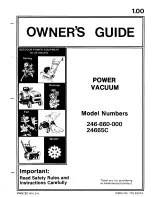
7
Insert Hose
Insert the push button end of the Locking
Hose into the inlet of the Vac. The hose
should snap into place. To remove the
hose from the Vac, press the release
button in the hose assembly and pull the
hose out of the Vac inlet, as shown.
WET/DRY VAC ASSEMBLY
(continued)
Vac Inlet
Power Head
Assembly
Release
Button
OPERATION
WARNING: To reduce the risk of fire, explosion, or damage to Vac:
• Do not leave Vac running while unattended - you may fail to notice important
signs indicating abnormal operation such as loss of suction, debris/liquid
exiting the exhaust, or abnormal motor noises. Immediately stop using Vac
if you notice these signs.
• Do not leave Vac plugged in when not in use.
• Do not continue running when float has cut off suction.
• Sparks inside the motor can ignite airborne flammables. Do not operate Vac
near flammable liquids or in areas with flammable gases, vapors, or
explosive/airborne dust. Flammable liquids, gases, and vapors include:
lighter fluid, solvent-type cleaners, oil-based paints, gasoline, alcohol, and
aerosol sprays. Explosive dusts include: coal, magnesium, aluminum,
grain, and gun powder.
• Do not vacuum up explosive dusts, flammable liquids, or hot ashes.
WARNING: To reduce the risk of electric shock or injury:
• Do not expose to rain or allow liquid to enter motor compartment. Store
indoors.
• Do not handle plug, switch, or Vac with wet hands.
• Unplug Vac before servicing. If your Vac is not working as it should, has
missing parts, has been dropped, damaged, left outdoors, or dropped into
water, return it to an independent service center or call customer service.
• When using an extension cord, use only outdoor-rated cords that are in
good condition. Do not allow the connection to come into contact with
liquid.
!
!
SP6881-1 Workshop:SP6439-3_ES.qxd 8/26/13 11:25 AM Page 7








































